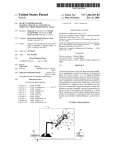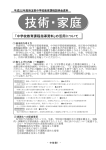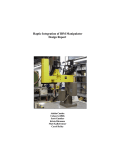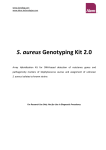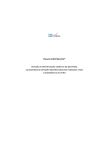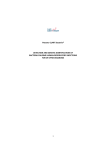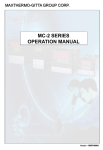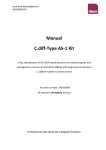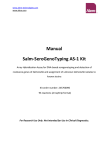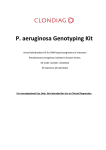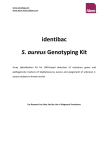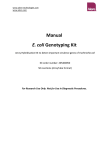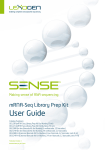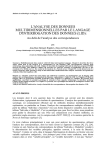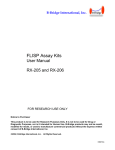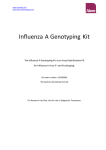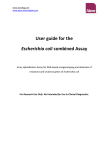Download Kit Manual - Alere Technologies GmbH
Transcript
Pseudomonas aeruginosa Genotyping Kit 2 Array Hybridisation Kit for epidemiological typing of Pseudomonas aeruginosa isolates. Kit order number: 245600096 96 reactions (ArrayStrip format) For Research Use Only. Not for Use in Diagnostic Procedures. www.clondiag.com www.alere.com Content BACKGROUND ................................................................................................................................. 1 GENERAL INSTRUCTIONS FOR USE ................................................................................................. 2 Intended Use................................................................................................................................ 2 Specifications ............................................................................................................................... 2 Technical Support ........................................................................................................................ 2 Safety Precautions ....................................................................................................................... 3 Material Safety Data Sheets (MSDS) ........................................................................................... 3 Shipping Precautions ................................................................................................................... 3 REAGENTS AND DEVICES................................................................................................................. 4 Assay Components, Storage and Stability ................................................................................... 4 DNA Labelling and Amplification .............................................................................................. 4 Hybridisation and Detection .................................................................................................... 4 Instrumentation & Software .................................................................................................... 5 Components required but not provided .................................................................................. 5 SOFTWARE INSTALLATION .............................................................................................................. 7 Assay Plugin and SDK for the ArrayMate..................................................................................... 7 Experiment String Collector ......................................................................................................... 9 Test the Assay Plugin ................................................................................................................. 10 PROTOCOL ..................................................................................................................................... 11 Culturing and Harvesting Bacterial Cells.................................................................................... 11 Extraction of DNA ...................................................................................................................... 11 Via Spin Columns (e.g. Qiagen DNeasy Blood&Tissue) .......................................................... 12 Linear Amplification and Internal Biotin Labelling .................................................................... 14 Hybridisation .............................................................................................................................. 14 General Remarks - Handling of Arrays ................................................................................... 14 General Remarks - Handling of Liquids .................................................................................. 15 General Remarks – the Substrate (Precipitating Dye) D1 ...................................................... 16 General Remarks - Thermoshakers ........................................................................................ 16 Protocol for Quantifoil’s BioShake iQ and Eppendorf’s Thermomixer Comfort with Microtitre Plate Adapter ........................................................................................................ 17 Data Analysis .............................................................................................................................. 18 Starting the ArrayMate Reader .............................................................................................. 18 Worklist .................................................................................................................................. 20 Data Acquisition in the ArrayMate Reader ............................................................................ 21 Results ........................................................................................................................................ 23 Export of Test Reports ............................................................................................................ 24 Contents of the Test Report ................................................................................................... 26 Kinship Analysis: Markers of the Core Genome (“KinCode” / “SNP Pattern”) ...................... 26 Marker Controls ..................................................................................................................... 26 Plausibility Controls ................................................................................................................ 27 Accessory Genome and Microevolution (“Features of the Isolate”) ..................................... 27 Recommendation for a Project Specific Database .................................................................... 28 String Collector ....................................................................................................................... 28 2 P. aeruginosa Genotyping Kit 2 05-16-04-004-V03_Manual_ P. aeruginosa.pdf www.clondiag.com www.alere.com Excel-Based Data Mining Tool ................................................................................................ 29 TROUBLESHOOTING ...................................................................................................................... 30 LITERATURE ................................................................................................................................... 33 ADDITIONAL INFORMATION ......................................................................................................... 34 Warranty .................................................................................................................................... 34 Quality Control ........................................................................................................................... 34 List of Components for Separate Order ..................................................................................... 34 CONTACT ....................................................................................................................................... 35 APPENDIX 1 – Flow Chart .............................................................................................................. 36 APPENDIX 2 – Probes and Primers for KinCode Genotyping and the Accessory Genome ........... 37 BACKGROUND The ALERE P. aeruginosa Genotyping Kit 2 is a quick and simple method for the DNA-based assignment of unknown P. aeruginosa isolates to phylogenetic lineages. RNA-free, unfragmented genomic DNA from pure and monoclonal P. aeruginosa colony material is amplified approximately 50-fold and internally labelled with biotin-11-dUTP using a linear amplification protocol. In contrast to standard PCR, a multiplex primer extension reaction is performed with two nested primers per target in each cycle. Two-versus-one primer for each target increase and synchronize the yield of biotin labelled single stranded (ss) DNA product for all markers. This allows a simultaneous sequence specific labelling and amplification of an essentially unlimited number of targets. However, sensitivity is lower than in a standard PCR (whereas contamination with amplicons is nearly impossible) and for that reason the method is restricted to clonal colony material and cannot be performed on samples such as swabs or other patient samples. Resulting biotin labelled ssDNA is transferred and hybridised to DNA oligonucleotide microarrays with 99 probes for different genetic markers plus controls. All of them are printed in five spots each. The array contains three different kinds of markers and each marker is represented by one or more probes: - 16 markers for kinship analysis (represented in total by 36 different probes) - 39 markers of the so called accessory genome (represented in total by 39 different probes) which may be used for the analysis of microevolutionary events - 24 probes for internal control of the analytic process. These probes test for proper DNA preparation (using conserved genes of P. aeruginosa), PCR (using a synthetic template), hybridisation (using control spots with biotinylated antisense partners) and staining reaction (using biotinylated control spots), respectively. Oligonucleotide probes are directly spotted onto the array, primers and control oligonucleotides are present in the MasterMix B1P2. The resulting typing data provide information for kinship analysis. Strain assignment using this information was described in detail by Wiehlmann et al. 2007, PNAS vol. 104 no. 19, p. 8101– 8106. P. aeruginosa Genotyping Kit 05-16-04-004-V03_Manual_ P. aeruginosa.pdf 1 www.clondiag.com www.alere.com GENERAL INSTRUCTIONS FOR USE Intended Use For Research Use Only. Not for Use in Diagnostic Procedures. This assay allows genotypic characterisation of P. aeruginosa isolates for research and epidemiological applications. It cannot be used for other bacteria than P. aeruginosa. Specifications Upon receipt the assay components need to be stored at different temperatures as specified on the package insert. The assay is to be performed at an ambient temperature of 18°C to 28°C. Technical Support If you require any further information on this product please contact: Alere Technologies GmbH Löbstedter Straße 103 -105 D-07749 Jena - Germany phone: +49 (0) 36 41 / 3111-0 fax: + 49 (0) 36 41 / 3111-120 [email protected] [email protected] 2 P. aeruginosa Genotyping Kit 2 05-16-04-004-V03_Manual_ P. aeruginosa.pdf www.clondiag.com www.alere.com Safety Precautions The assay is intended for use by personnel that are trained in microbiological and molecular methods. Preparation of DNA from pure P. aeruginosa colonies (clones) requires expertise in microbiology and the local regulations for handling of pathogenic microorganisms (biosafety level 2) are to be obeyed. Isolated, cell-free P. aeruginosa DNA may be processed without further biosafety precautions, although contamination with P. aeruginosa or other bacteria needs to be ruled out. Always wear protective clothes as required for laboratory work by your local regulations. Material Safety Data Sheets (MSDS) According to OSHA 29CFR1910.1200, Commonwealth of Australia [NOHSC: 1005, 1008(1999)] and the latest amendments to the European Union Directives 67/548/EC and 1999/45/EC, the enclosed reagents do not require a Material Safety Data Sheet (MSDS). They do not contain more than 1% of a component classified as hazardous and do not contain more than 0.1 % of a component classified as carcinogenic. MSDS therefore are not provided. Nevertheless, the buffers may cause irritation if they come into contact with eyes or skin, and may cause harm if swallowed. The regular precautions associated with laboratory work should be obeyed (e.g., wear protective goggles, gloves and lab coat and avoid contact with the reagents). In case, any liquids are spilled, clean with disinfectant and/or laboratory detergent and water. Alere assumes no liability for damage resulting from handling or contact with these products. If you have any questions please contact our Technical Support (see above). Shipping Precautions RID/ADR: “Kein Gefahrgut”/ No dangerous goods IMDG: No dangerous goods IATA: No dangerous goods P. aeruginosa Genotyping Kit 2 05-16-04-004-V03_Manual_ P. aeruginosa.pdf 3 www.clondiag.com www.alere.com REAGENTS AND DEVICES Assay Components, Storage and Stability All reagents are provided in a certain surplus amount (see below). In case of need, all components may also be ordered separately; please refer to the order numbers at the end of this user guide. For pricing please contact your local representative or our customer service, respectively. The expiry date can be found on each bottle and on the outer package. All components have been tested for stability for short term shipment (<1 week) at ambient temperature (< 37 °C). The assay components with a rather limited stability are D1 and C3. The other components have proven to be stable for up to six months after the assay expiry date has passed. DNA Labelling and Amplification B1P2: 2x Labelling Buffer. Store at 2-8 °C. Surplus: 25%. B2: Labelling Enzyme. Store at 2-8 °C. Surplus: 50%. Hybridisation and Detection ArrayStrips P.aeruginosa-4 (12 x 8 samples); protected against light and sealed under inert gas. Store at 15°C to 28°C. After opening to be used within two weeks. Close the unused wells with caps, protect them against humidity and dust and store them at a dark place. Please note: Avoid any touching or scratching of the surface of the microarray at the bottom of the well. Do not store or handle unused wells at an air humidity of more than 60% since this may irreversibly corrode the spots. 4 ArrayStrip Cover(24 strips) C1: Hybridisation Buffer. P. aeruginosa Genotyping Kit 2 05-16-04-004-V03_Manual_ P. aeruginosa.pdf www.clondiag.com www.alere.com Store at 18-28 °C, protect against sunlight. Surplus: 100%. C2: Washing Buffer 1. Store at 18-28 °C, protect against direct sunlight. Surplus: 100%. C3: HRP Conjugate 100x. Store at 2-8 °C, protect against direct sunlight. Surplus: 100%. C4: Conjugate Buffer. Store at 18-28 °C, protect against direct sunlight. Surplus: 200% C5: Washing Buffer 2. Store at 18-28 °C, protect against direct sunlight. Surplus: 200%. D1: Horseradish Peroxidase Substrate. Store at 2-8 °C, protect against direct sunlight. Surplus: 50%. Instrumentation & Software ArrayMate Reader (to be ordered separately, for details see below) The P. aeruginosa Genotyping assay may be used on the ArrayMate reader only. The alternative devices ATR01/03 are not suitable for reading ArrayStrip based assays. In case of any questions please contact us. Iconoclust software (provided with the reader) Test specific software plug-in (can be downloaded from Alere/CLONDIAG´s website, check periodically for updates, for details see below). Information (such as spot names, marker names, location of the spots on the array, size of the image taken by the reader’s specific camera) is delivered with the reader or can be downloaded from our website. These testspecific plug-ins will occasionally be updated. Please check the NEWS section of our website www.alere-technologies.com. Support is available under [email protected]. Components required but not provided Growth media for the cultivation of P. aeruginosa The test should be performed with colonies harvested from Columbia blood agar. Other nutrient-rich media (e.g. 2xTY or LB) may also suffice, but have not systematically been tested. Liquid media should not been used because contaminations or mixed cultures cannot easily be ruled out. P. aeruginosa Genotyping Kit 2 05-16-04-004-V03_Manual_ P. aeruginosa.pdf 5 www.clondiag.com www.alere.com Equipment and consumables needed for the cultivation of P. aeruginosa (incubator, inoculation loops, Petri dishes) DNA preparation kits: The assay has been tested with the DNeasy Blood & Tissue Kit from Qiagen (cat# 69504) and High Pure DNA Isolations Kit from Roche (Cat. No. 11796828001). Please note: The DNA specimen needs to be free of RNA. Recommendation: a pretreatment with RNase A while DNA preparation. 1x PBS RNAse A (we recommend Qiagen’s RNase A solution, 100 mg/ml, Qiagen order# 19101) Equipment needed for DNA isolation, e.g. pipettes, centrifuge, thermoshaker or automated device (see above) Photometer (OD 260 nm) for measuring the concentration of DNA Equipment for non denaturing agarose DNA gel electrophoresis for quality control of DNA Thermocycler for PCR Thermoshaker We strongly recommend the BioShake iQ by Quantifoil Instruments (http://www.qinstruments.com/) equipped with a customised heating block designed to fit ArrayStrips. Alternatively, you may use Eppendorf’s Thermomixer Comfort, equipped a heating block for microtitre plates. Pipettes: suitable for 1µL-5µL volumes, 90µL, 100µL, 200µL, 1000µL Multichannel Pipettes for 100-200 µL Reaction vials suitable for PCR Ultrapure (PCR grade) water 6 P. aeruginosa Genotyping Kit 2 05-16-04-004-V03_Manual_ P. aeruginosa.pdf www.clondiag.com www.alere.com SOFTWARE INSTALLATION For analysis of the final image of the DNA microarray on the ArrayMate a specific software plugin is required. This software plugin can be downloaded from our website www.alereH technologies.com under “Downloads” (plug-ins). Please install it on your reader according to the following instructions. Further analysis can be made after transferring the data from the ArrayMate to your computer by using the “Experiment String Collector” and the “Excel-Based Data Mining Tool” (see page 29). Assay Plugin and SDK for the ArrayMate The following instruction describes the installation of the AssayPlugin and ArrayMate installation software (SDK). 1. Download the AssayPlugin and the ArrayMate SDK from www.alere-technologies.com. 2. Copy downloaded files (Plugin and SDK setup) to an USB Memory Stick and connect it to the ArrayMate 3. Log on as user admin to the ArrayMate (default password: 12345) 4. Open the Windows Explorer and navigate to the downloaded setup files. P. aeruginosa Genotyping Kit 2 05-16-04-004-V03_Manual_ P. aeruginosa.pdf 7 www.clondiag.com www.alere.com 5. Start installation: double click on setup file of the AssayPlugin 6. The welcome screen of the setup appears 7. Follow the instructions and press Finish to complete the installation 8. Repeat this process for the SDK Setup 9. Log off and log in again as User R&D (password: abcde) 8 P. aeruginosa Genotyping Kit 2 05-16-04-004-V03_Manual_ P. aeruginosa.pdf www.clondiag.com www.alere.com Experiment String Collector The Experiment String Collector is a tool to collect the main experiment information from a set of experiments from the ArrayMate. The use of this tool is described below. 1. Download the Experiment String Collector from www.alere-technologies.com to your computer 2. Start the Setup executable (a welcome screen will appear) 3. Follow the instructions and press Finish to complete. The software will start automatically after the installation. Please Note: The Experiment String Collector is designed to work on Windows 7. P. aeruginosa Genotyping Kit 2 05-16-04-004-V03_Manual_ P. aeruginosa.pdf 9 www.clondiag.com www.alere.com Test the AssayPlugin The Software installation can be tested with the unprocessed Array by the following steps: 1. Log on to the ArrayMate in User R&D Mode (default password: abcde) and start a New Run 2. Choose automatic detection in Experiment Infos and press Next. Place the strip rack with the unprocessed ArrayStrip into the ArrayMate than press Next 3. After the Experiment Run the ArrayMate automatically enters the Archive mode and displays the results of the last experiment. 4. Each cell of the columns image, raw data and results must contain an “X”. Otherwise, please retry the installation process of the AssayPlugin and the installation software (SDK). 10 P. aeruginosa Genotyping Kit 2 05-16-04-004-V03_Manual_ P. aeruginosa.pdf www.clondiag.com www.alere.com PROTOCOL Please note: All protocol steps described here in detail are also available as a short flow chart protocol (see Appendix 1). Culturing and Harvesting Bacterial Cells P. aeruginosa strains are potential pathogens. All procedures for cultivation of the bacterium and DNA preparation need to be performed by properly trained staff in a biosafety level 2 facility. Grow P. aeruginosa on Columbia blood agar (overnight at 37°C or 48 hrs at room temperature). Make sure that you have a pure, monoclonal culture of P. aeruginosa. Contamination with other bacteria, especially with other non-fermenting Gram-negative rods needs to be strictly avoided. If necessary, sub-clone, and incubate again. Extraction of DNA The required sample type for the P. aeruginosa genotyping assay is 0.5-2 µg (cDNA = 0.1-0.4 µg/µl) of intact genomic DNA from a single clone. The DNA specimen needs to be free of RNA and it should not be fragmented. This can be determined by agarose gel electrophoresis. DNA should not be prepared by disrupting P. aeruginosa cells using bead beaters, ultrasonication or aggressive chemicals such as in alkaline lysis protocols. Most performance problems with the P. aeruginosa genotyping assay are due to insufficient amounts or quality of DNA preparation. We therefore strongly recommend following the protocols outlined below. The use of automated systems for DNA preparation (EZ1, Qiacube, Magnapure etc.) has not yet been systematically evaluated with this assay. While there are positive experiences with some of our other assays, we recommend testing some known strains for evaluation prior to routine use of these systems. Lysis steps and addition of RNase should be performed as described below before loading the samples in an automated system for DNA preparation. P. aeruginosa Genotyping Kit 2 05-16-04-004-V03_Manual_ P. aeruginosa.pdf 11 www.clondiag.com www.alere.com Via Spin Columns (e.g. Qiagen DNeasy Blood&Tissue) Add an inoculating loop full of monoclonal colony material of the P. aeruginosa isolate to 0.2 ml 1xPBS and vortex thoroughly. Loop empty Loop full It is important to harvest enough bacteria; this is a prerequisite for extraction of a sufficient amount of DNA. Take an inoculating loop of 1mm diameter filled with bacteria as shown in the left picture. Proceed with the DNA preparation protocol of the DNA preparation kit. For the Qiagen DNeasy Blood&Tissue Kit that is as follows: Add 20 µL proteinase K (Qiagen Kit, or equivalent) and add 200 µL buffer AL (Qiagen Kit) Vortex shortly or shake vigorously. Incubate for 30-60 min at 56°C and 550 rpm in the thermoshaker. Add 4 μl RNase A (100 mg/ml), mix by vortexing, and incubate for 2 min at room temperature before continuing Add 200 µl ethanol (96-100 %) Vortex the sample and centrifuge shortly. Transfer the complete content of the tube (including any precipitate) into a spin column that is placed in a 2 ml collection tube. Centrifuge at room temperature, time and speed need to be determined depending on viscosity of the sample and type of centrifuge used (e.g., 1 min at 8000 rpm). All liquid should be collected in the collection tube afterwards. Discard collection tube with liquids. Place the spin column in a new 2 ml collection tube (provided with the Qiagen kit). Add 500 µl Buffer AW1. 12 P. aeruginosa Genotyping Kit 2 05-16-04-004-V03_Manual_ P. aeruginosa.pdf www.clondiag.com www.alere.com Centrifuge at room temperature (e.g., 1 min at 8000 rpm). Discard collection tube with liquids. Place the spin column in a new 2 ml collection tube (provided with the Qiagen kit). Add 500 µl Buffer AW2. Centrifuge at room temperature, the membrane of the spin column should be dry, and all liquid should be in the collection tube (e.g., 3 min at 14000 rpm). Discard collection tube with liquids. Place the spin column in a clean 1.5 ml tube (not provided with the Qiagen kit). Add 50 µl Buffer AE (or PCR grade distilled water) directly onto the membrane of the spin column. Incubate at room temperature for 5 min to elute DNA. Centrifuge (e.g., 1 min at 8000 rpm). Optional: add another 50 µl Buffer AE (or PCR grade distilled water) directly onto the membrane, incubate at room temperature for 1-5 min and centrifuge again. Discard the spin column. Please note : Ethanol from Washing Buffers strongly inhibits the enzymes used in the assay. Such contamination might occur during elution of prepared DNA by drops adhering to the funnel of the spin columns. Thus these funnels should be gently touched and tried with sterile filter paper or wipes prior to the elution step. Alternatively, prepared DNA can shortly be heated to evaporate ethanol (e.g., 10 min at 70 °C with open lid). Check for DNA integrity and absence of RNA (e.g., agarose gel). If necessary, you might perform another digestion step with additional RNase A (not provided). Measure DNA concentration (A260 method), it shouldn´t be less than 0.1 µg/µl. The concentration might be increased by heating and evaporation of water, or by using a speed vac centrifuge. P. aeruginosa Genotyping Kit 2 05-16-04-004-V03_Manual_ P. aeruginosa.pdf 13 www.clondiag.com www.alere.com Linear Amplification and Internal Biotin Labelling Please keep in mind the limited surplus of reagents whilst pipetting. The surplus of B1P2 labelling reagent is 25 %. Prepare a Master Mix by combining 4.9 µL of B1P2 labelling reagent and 0.1 µL of B2 (DNA polymerase) per sample. Add 5 µl of P. aeruginosa DNA (cDNA = 0.1-0.4 µg/µl) prepared as described above to 5 µl of the Master Mix (B1P2/B2). Do not forget to label the vial! Perform amplification in a pre-programmed thermocycler (e.g., Eppendorf Mastercycler gradient with heated lid, VWR, cat No. 460-0108) according to following protocol: Pre-heat cover/lid to 105°C 300 sec at 96°C 20 sec at 62°C 50 cycles with 40 sec at 72°C 60 sec at 96°C Cool down to 4°C, hold The amplification products can be stored frozen until usage Please note: When using another device, some adaptations might be necessary. Before starting routine use, please test the protocol with a few known reference strains. Hybridisation General Remarks - Handling of Arrays Never touch the array surface! Avoid complete drying of the array surface during processing! Do not allow it to stay without liquid for more than two minutes! Never rinse the wells with distilled water after the hybridisation step, use only C2 Washing Buffer! 14 P. aeruginosa Genotyping Kit 2 05-16-04-004-V03_Manual_ P. aeruginosa.pdf www.clondiag.com www.alere.com Unused wells should be capped during the whole procedure. The strips may be processed up to three times without a loss of quality of properly capped unused arrays. Close all wells that will not be used with a cap und leave it there until you use these wells (for storage conditions after use: see section “Assay components, storage and stability/Hybridisation and Detection”). Always label your array strips with a laboratory marker at the recommended position. Never label them on the bottom or across the data matrix barcode! This may cause an error. Avoid contact of data matrix barcode with organic solvents! The ArrayMate needs the information encoded in the data matrix to perform the assay and the analysis afterwards. Avoid touching the bottom of the microarray strip and keep it clean. General Remarks - Handling of Liquids We recommend the use of a multichannel pipette and reagent reservoirs. Please keep in mind the limited surplus of C1 (100 %). We strongly recommend that the liquid is removed by pipetting rather than by inverting the strips and flicking the liquids out. Fine tipped soft, disposable Pasteur pipettes are suited best (such as BRANDT / Cat. No. 612-2856). Always place the pipette tip at the cavity between the array and the wall of the reagent well. If you touch the array surface, probes may be scratched off and this may cause an error. P. aeruginosa Genotyping Kit 2 05-16-04-004-V03_Manual_ P. aeruginosa.pdf 15 www.clondiag.com www.alere.com General Remarks – the Substrate (Precipitating Dye) D1 An appropriate amount of substrate (precipitating dye) should be filled into an Eppendorf tube and taken out of the refrigerator when starting the procedure allowing it to pre-warm to room temperature / 25 °C. Cold D1 may yield weak signals. D1 should shortly be centrifuged prior to use to remove bubbles as well as possible precipitates. Triggered by peroxidase, in case of positive reactions, the dye precipitates but it is not covalently bound. The precipitate can be dissolved by vigorous shaking. Thus the arrays must not be shaken, dropped or moved abruptly during the staining procedure and afterwards. After completion of staining, remove and discard reagent D1 as completely as possible and scan immediately. The dye precipitate fades slowly in presence of liquids. General Remarks - Thermoshakers The correct temperature within the vessels is essential; therefore always use the appropriate equipment for heating. Because of a possibly inhomogeneous distribution of the temperature within the heating block and because of possible differences between displayed and actual temperatures, the use of different brands of thermoshakers might affect test performance. We tested the assay with BioShake iQ by Quantifoil Instruments (http://www.qinstruments.com/) equipped with a customised heating block designed to fit ArrayStrips and Eppendorf’s Thermomixer Comfort, equipped with a heating block for microtitre plates. When using other devices, some modifications to the protocol might be necessary. Before starting routine use, please test the protocol with a few known reference strains or with the control DNA (P. aeruginosa PAO1). 16 P. aeruginosa Genotyping Kit 2 05-16-04-004-V03_Manual_ P. aeruginosa.pdf www.clondiag.com www.alere.com Protocol for Quantifoil’s BioShake iQ and Eppendorf’s Thermomixer Comfort with Microtitre Plate Adapter Switch on the thermoshaker and let it pre-heat to 60 °C. Remove the ArrayStrip(s) from the pouch. Insert the ArrayStrip(s) into the white frame. Assure the correct orientation (data matrix barcode close to row A) and proper fit. Pre-wash the array in two steps: First, PCR-grade distilled water, 200 µl per well, just pipette 4x up and down, remove and discard. Second, C1 Hybridisation Buffer, 200 µl per well, at 60 °C, 2 min and 550 rpm in the thermoshaker. Add 90 µL of buffer C1 to each tube with (10 µL) labelled amplification product, mix gently. Remove the buffer from the well with the array and add the mixture of C1 and labelled amplification product. Incubate at 60 °C, 60 min and 550 rpm in the thermoshaker. Meanwhile, prepare conjugate: for each experiment add 1 µl conjugate 100x HRP to 100 µl C4 Conjugation Buffer. This mixture is stable for around one working day at room temperature; C3 is delivered with a surplus of 100%, C4 is delivered with a surplus of 200%. Suggested pipetting scheme: C3 C4 1 well 1.5 µl 150 µl 2-3 wells 3.5 µl 350 µl 4-6 wells 7 µl 700 µl 7-10 wells 11 µl 1100 µl 11-15 wells 16 µl 1600 µl 16-20 wells 21 µl 2100 µl 21-30 wells 32 µl 3200 µl Remove liquid from the well and add 200 µl C2 Washing Buffer, discard C2. Repeat this step twice. P. aeruginosa Genotyping Kit 2 05-16-04-004-V03_Manual_ P. aeruginosa.pdf 31-40 wells 42 µl 4200 µl 17 www.clondiag.com www.alere.com The thermoshaker needs some minutes to cool down from 60 °C to 30 °C. To speed up use the cooled cover (for Quantifoil’s BioShake iQ, can be ordered from Quantifoil) or an ice pack (Eppendorf’s Thermomixer Comfort). After removal of C2 Washing Buffer add 100 µl diluted conjugate to each well, incubate at 30 °C, 10 min and 550 rpm in the thermoshaker. Remove liquid and wash with 200 µl C5 Washing Buffer, pipette 4x up and down, remove and discard. Repeat this step. Add 100 µl of D1 substrate (precipitating dye, at 25 °C, see above) per well. Incubate at 30 °C, 5 min in the thermoshaker, but do not shake! Remove liquid completely. The bottom of the ArrayStrips may be cautiously be cleaned with wipes, bubbles may be removed by removing and adding D1. Scan and process (see below). Data Analysis Starting the ArrayMate Reader We recommend starting the ArrayMate Reader after having started the hybridisation; this allows you to conveniently start the device and to import the worklist file (see below) Please note that this is a short instruction only. For more detailed information please refer to the ArrayMate User Manual. Switch on the ArrayMate (main switch on the rear below the electric cable plug, operating switch on the bottom/left corner of the front side). 18 Switch on the screen (switch right hand below the screen). P. aeruginosa Genotyping Kit 2 05-16-04-004-V03_Manual_ P. aeruginosa.pdf www.clondiag.com www.alere.com Log on as R&D User (Research and Development User) for full access to test specific software (a default password will be provided together with the ArrayMate device). If you log on as User, you will obtain only raw values, but no interpretation as positives/negatives and no strain assignment. Administrator log-in will allow manipulation of file folders and software; and this should be done only upon direct advice of Alere’s IT team. The user interface will be loaded, ArrayMate performs internal testing. This will require less than a minute. Click on the icon New Run (left upper edge of the screen). A suggestion for a run name / folder name for the new run appears in the top line of the screen. You may modify or change the experiment name at your convenience. Type in your operator ID (optional). You may enter a comment into the memo field (optional). P. aeruginosa Genotyping Kit 2 05-16-04-004-V03_Manual_ P. aeruginosa.pdf 19 www.clondiag.com www.alere.com Worklist A Worklist file allows linking an identifier such as a laboratory/sample number to a position of an array within the ArrayStrip. For privacy reasons, arrays should not be identified by patient names. Worklists can be generated using spreadsheet software such as EXCEL (see below) but must be saved in the *.txt file format that can be imported into the test specific ArrayMate software. Do not use special characters (such as : ; ()[] / \ ä ü etc.). Create a list with at least three columns with obligatory headers in the order: position / sample ID / assay ID (Table 1). Positions are continuously numbered from 1 to a maximum of 96. Position 1 would correspond to A1, 8 to H1, 9 to A2 and 96 to H12 (Table 2). Do not leave empty lines in the worklist. If you use EXCEL, position numbers should be typed into column A. Sample ID is strain / sample / laboratory number such as exported from your LIMS (or assigned in any different way). Patient name should not be used as Sample ID. The Assay ID enables the system to identify the current test and to correctly use information on layout, spot number, and identity etc.. P. aeruginosa Genotyping 2 Assay has the Assay ID: 10418. Assay ID numbers must not be confused as this could lead to errors or loss of data. You may add further columns and headers with notes and comments at your convenience. Information from these columns will not appear on the result screen or in the Test Report. We recommend using a printout of the worklist as template for pipetting. Safe the worklist as tab separated *.txt file on the memory stick provided together with the ArrayMate. To avoid confusion, make sure that worklists are named unambiguously or that worklists from earlier experiments are deleted. 20 P. aeruginosa Genotyping Kit 2 05-16-04-004-V03_Manual_ P. aeruginosa.pdf www.clondiag.com www.alere.com Table 1: Example worklist: Position 1 2 3 4 5 6 7 8 sampleID 2013-12345 2013-12346 2013-12347 2013-12348 2013-12349 2013-12350 987654 P. aeruginosa PAO1 assayID 10418 10418 10418 10418 10418 10418 10418 10418 comment Isolate referred from Dr. J. Doe. Control strain Table 2: Positions in the 96 well format A B C D E H G H 1 1 2 3 4 5 6 7 8 2 9 10 11 12 13 14 15 16 3 17 18 19 20 21 22 23 24 4 25 26 27 28 29 30 31 32 5 33 34 35 36 37 38 39 40 6 41 42 43 44 45 46 47 48 7 49 50 51 52 53 54 55 56 8 57 58 59 60 61 62 63 64 9 65 66 67 68 69 70 71 72 10 73 74 75 76 77 78 79 80 11 81 82 83 84 85 86 87 88 12 89 90 91 92 93 94 95 96 Data Acquisition in the ArrayMate Reader Insert your memory stick containing the worklist into any of the USB ports down to the right side of the ArrayMate. Press the button Select your worklist (path: “My Computer/Removable Disk”). Open your selected worklist with Enter or the button Open. Press the button ; a folder selection dialog will open. (your imported worklist opens in a separate window). Proofread. If the new window is empty, or if it was the wrong worklist, repeat the import. Press the button OK; the worklist window will close. P. aeruginosa Genotyping Kit 2 05-16-04-004-V03_Manual_ P. aeruginosa.pdf 21 www.clondiag.com www.alere.com Leave the memory stick attached to the ArrayMate if you intend to export Test Reports afterwards. Press the button Next (bottom / right on the screen; reader opens). Carefully insert the appropriate metallic adapter / frame into the ArrayMate. Do not apply any strong force. Assure proper fit, otherwise the images may be out of focus. Carefully insert the white frame with the array strips into the metallic adapter. Assure the correct orientation (Position A1 in the frame next to the data matrix barcode on the adapter) and proper fit, otherwise the images may be out of focus. ArrayStrip frame with Strips inserted in accordance with the worklist. Please note: ArrayStrips must be clean. They should not contain any liquids during analysis. Barcodes must be clean. There must be no ArrayStrip Covers on the wells to be analysed (however, unused wells should remain covered). Press the button Next (bottom / right on the screen; reader closes, analysis program starts, reading takes 2-10 min dependent on the number of strips; reader takes images, and automatically analyses the data). The progress of the reading is indicated by the following symbols: photographed: in analysis: ready: The reader indicates the end of the entire process with an acoustic signal (beep). Press the button Next (bottom / right on the screen; reader opens). Remove the white frame with the ArrayStrip(s). Press the button Next (bottom / right on the screen; reader closes). 22 P. aeruginosa Genotyping Kit 2 05-16-04-004-V03_Manual_ P. aeruginosa.pdf www.clondiag.com www.alere.com Results On the left hand side of the screen you will see a list showing all runs stored on the ArrayMate´s hard disk. A run contains the results from all arrays analysed together within one frame. If this list is not displayed: Press the button Archive (left hand) and activate the flag Browse (top left). The runs are organised like folders in “Windows Explorer”, and named by default according to the date of acquisition. Example: There is one experiment run in this archive: If you click on the plus symbol left on the run name, the folder opens and you will see a list of the individual arrays ordered by Sample ID. P. aeruginosa Genotyping Kit 2 05-16-04-004-V03_Manual_ P. aeruginosa.pdf 23 www.clondiag.com www.alere.com Click on a Sample ID and the P.aeruginosa 2 Genotyping Report for this array is shown in the window on the right: Export of Test Reports Two result files in html-format will be generated. The shorter report gives a summary on genotyping information. A longer html result sheet (“result_B.res.html”) provides information on all probes. Possible error messages in these reports are explained below (see Troubleshooting). Other files that are generated and can be exported include A *.csv file containing the experimental result as a string which can be imported into an Excel-based list (for data mining; see chapter 3 below), A *.txt file with the raw measurements, An image file (*.bmp) showing the actual photo of the array, A second image file (*.png) in which the coordinate grid is superimposed and the recognised spots are circled, and A *.xml file providing the same information as the html result sheet for future export into databases etc., A *.log file containing specific data of the evaluation of spots and substances, An *.out file containing output log data which help our service to trace image evaluation errors. 24 P. aeruginosa Genotyping Kit 2 05-16-04-004-V03_Manual_ P. aeruginosa.pdf www.clondiag.com www.alere.com Please note: Only complete runs can be exported. The export of individual Test Reports is not possible. Right-click on the selected run (a menu appears with the option Export Run). Right-click on Export Run (a file browser opens). Click on My Computer, subsequently on Removable Disk, and choose the folder to save or click on the button Make New Folder (on the bottom; a new folder icon appears). Rename the new folder (e.g. with the experiment run name or date). Click on the OK button (data are exported into the new folder on your memory stick). Do NOT remove the memory stick as long as the hourglass symbol is visible. Switch off the device by clicking on the Power-button (left / down on the screen): Switch off the Screen. There is no need to physically switch off the ArrayMate. P. aeruginosa Genotyping Kit 2 05-16-04-004-V03_Manual_ P. aeruginosa.pdf 25 www.clondiag.com www.alere.com Contents of the Test Report The ArrayMate creates a test report that lists all markers analysed along with an individual test result for each marker. In addition, the test report provides a rating of the data quality along with identification of a possibly erroneous step of the experimental process. The html file (*.html) may be viewed with any browser software (e.g. Internet Explorer, Firefox etc.) and may be printed or converted into a *.pdf file (for details please refer to the ArrayMate’s user manual). The contents of the test report are described in more detail in the following section. Kinship Analysis: Markers of the Core Genome (“KinCode” / “SNP Pattern”) Sixteen different markers of the core genome were selected for genetic identification of P. aeruginosa isolates. In the test report, these markers are named “SNP Pattern” and are formatted as a string of 16 digits. Each digit may adopt the value “0”, “1”, “2”, “X”, respectively. Strings containing “0” and “1” digits are used for deriving the four-digit alphanumeric “KinCode” which contains all information of the 16 digit code, but is easier to comprehend. However, if the test result of some digit is unclear, it is rated “2” in the 16 digit string. If the test result of a marker is invalid, it is rated “X” in the 16 digit string, and then the four-digit KinCode remains incomplete. In these cases, the respective alphanumeric digit of the KinCode is replaced by “X“. For each complete KinCode, background information regarding the frequency of the respective code is given, based on a data base established by L. Wiehlmann (unpublished). SNP pattern and KinCode were described by Wiehlmann et al. 2007 (see literature). Marker Controls These controls are important for the rating of data quality. Furthermore, in case of handling mistakes they provide important information regarding the experimental step that may have failed. 26 P. aeruginosa Genotyping Kit 2 05-16-04-004-V03_Manual_ P. aeruginosa.pdf www.clondiag.com www.alere.com If the Staining Control failed (and along with it all other controls) this indicates failure of the Horseradish Peroxidase-mediated conversion of D1, that means a failure of one of the steps after hybridisation. If all controls (including the Hybridisation Control) failed, but not the Staining Control, this indicates a failure of the Hybridisation step. If the Labelling, Genus/Species and DNA Stringency Control failed, but not the Hybridisation Control and the Staining Control, this indicates a failure of PCR. If only the Genus/Species and DNA Stringency Control failed, this indicates poor quality of DNA. Failure of Negative Controls indicates a high nonspecific signal background. Please refer to the troubleshooting section below for further information. Plausibility Controls Some combinations of markers in nature are impossible to occur for biological reasons. The software checks for those combinations and returns a warning if they are diagnosed. In these cases the test result is implausible. Please refer to the troubleshooting section below for further information. Accessory Genome and Microevolution (“Features of the Isolate”) In addition to the markers that characterise a clone, additional markers of the accessory genome were added to the array. Originally (Wiehlmann et al. 2007), 41 markers of the accessory genome had been selected, but meanwhile two of them (TB-C47-1 and TB-C47-2) have been removed because of faulty results. The remaining 39 markers are listed in the test report as “Features of the Isolate” and they may be exported along with the KinCode as a 39 digit code in the “0”, “1”, “2” or “X” format as described above. This information may be used to characterise microevolutionary events within a clone that is characterised by a uniform core genome pattern. The markers of the accessory genome have been described in detail by Wiehlmann et al. 2007 (see literature). P. aeruginosa Genotyping Kit 2 05-16-04-004-V03_Manual_ P. aeruginosa.pdf 27 www.clondiag.com www.alere.com Recommendation for a Project Specific Database The CSV file (*.csv), which contains the experimental result as a string. For comparison of the results and for data mining each of these strings may be imported into an “Excel Based Data Mining Tool” (see 3.1) as suggested by Wiehlmann et al. (2007). Alere Technologies provides a drawing of this Excel sheet that has been developed from the sheet suggested by Wiehlmann et al. Further, Alere Technologies provides a tool (the “Experiment String Collector” see 3.2) that enables the user to collect the strings from all *csv files within one folder in one single step. Both, the Excel datasheet and the string collector, are described in the following section. String Collector The tool called “Experiment String Collector” enables the user to collect all data (strings) from *.csv files found within one folder into one output *.csv file (CommaSeparatedValue files being generic files for export into spreadsheet programs). As outlined above and in the ArrayMate manual, the results of each experimental run can be exported from the ArrayMate to an USB stick into a folder. In order to collect all data strings found within this folder into a single *.csv file, proceed as follows: Download the string collector from our website www.alere-technologies.com and HU UH install it on your office computer according to the instructions you will find in the Software and Reader section of this manual. Open the string collector by double clicking its icon on your desktop; the main window appears: 1 2 28 Select the path of the source folder (the folder of the ArrayMate Data export) by clicking P. aeruginosa Genotyping Kit 2 05-16-04-004-V03_Manual_ P. aeruginosa.pdf www.clondiag.com www.alere.com into area 1 (indicated by the first red circle on the image above) Select the path of the target folder (the folder to save the *.csv file containing the collected data strings) by clicking into area 2 (indicated by the second red circle on the image above) Single click the generate button; all *.csv files in the source folder will be scanned, and the content will be collected within one *.csv file named Experiments_YYYY_MM_DDHH_MM_SS.csv Click on the button open File; the Experiments.csv file created opens in the notepad text editor The content of the new *.csv file may now be transferred into an Excel-based Data Mining Tool by copy / paste. Excel-Based Data Mining Tool An Excel-Based Data Mining tool was developed together with the group of Lutz Wiehlmann. The template for a user specific data sheet can be downloaded from our website: www.aleretechnologies.com. The Excel sheet draft is separated into two areas: The first area (columns A to M) is meant for entering data like source of the specimen manually. The second area (columns N to BS) is meant for pasting experiment results provided by the ArrayMate in the *.csv files in a copy / paste manner. These data consist of the Identifier of the result, the date of test, the KinCode and the strings for SNP pattern and Features of the Isolate as a 16 + 39 digit string that may be used for Kinship Analysis. In order to copy the data from an individual *.csv file into the data mining list proceed as follows: P. aeruginosa Genotyping Kit 2 05-16-04-004-V03_Manual_ P. aeruginosa.pdf 29 www.clondiag.com www.alere.com Open the *.csv-file of the experiment with any editor program (Editor, Notepad, etc.), select and copy “all“ paste the string into the data mining list in the “Pseudomonas test results” table, column N “Identifier of result” Enter the appropriate additional data into columns A to M manually In case it is intended to enter the result of more than one array into the database we recommend the use of the String Collector (see below). TROUBLESHOOTING For training and qualification purposes we recommend our Control-L Kit (Alere order number 205500010). In case of doubt, this kit is the perfect tool to make sure that your laboratory processes are working correctly. It may also be used for the functional testing of individual kit components. Poor DNA Quality: Only the DNA Extraction Control failed. In these cases we recommend to recheck DNA quantity and quality by loading leftover DNA on an agarose gel. The amount of DNA is crucial. A260 readings will cover RNA and other contaminants as well. Therefore pure DNA preparation without bulk amounts of RNA is prerequisite for proper DNA concentration measurement. RNAse treatment prior to A260 reading therefore is necessary (component A2 contains RNAse). 30 P. aeruginosa Genotyping Kit 2 05-16-04-004-V03_Manual_ P. aeruginosa.pdf www.clondiag.com www.alere.com Some P. aeruginosa colonies protect themselves with thick layers of slime. It may help to wash the bacterial pellet 3x in 1 ml of 5 mM EDTA, pH 7.0 (re-suspend and centrifuge at 3,000 × g for 6 min at room temperature, discard the supernatant). DNA must not be fragmented, as fragmentation reduces the efficiency of amplification and labelling due to the distance between primer and probe binding sites. DNA should be free of RNA, as free RNA reduces the efficiency of amplification and labelling by effectively removing primer from the reaction mix due to competitive hybridisation. DNA must be free of any traces of ethanol, as ethanol strongly influences the amplification. This is an important issue as, e.g., in the top of QIAGEN tubes a drop of ethanol-containing washing buffer might get trapped. The tubes really need to be centrifuged on high speed. Alternatively, it is possible to heat the sample prior to adding it to the labelling mix (some 5 minutes at 70 °C). Some problems with samples from the Qiagen EZ1 device for example were resolved after heating the samples. All reagents for DNA extraction need to be within the recommended shelf-life and stored in the appropriate way. We have good experience with the manual QIAGEN DNeasy Kit and the automated device EZ1. Contrarily, alkaline lysis, mechanical bead-beater extraction or ultrasonication in our hands resulted in poor DNA recovery, poor DNA quality or both. An alternative method that is fast and simple but that did work in the hands of several customers was described by Wiehlmann et al. 2007 (see literature) PCR failed: Labelling and DNA Extraction Controls failed, but not the Hybridisation Control and the Staining Control. In this case, please carefully review the PCR process for correctness. In some cases, inhibitors of PCR are isolated along with DNA. In these cases a rerun of DNA purification may help. Hybridisation failed: All controls (including the Hybridisation Control) failed, but not the Staining Control. In this case please carefully review the hybridisation step. Was the buffer (C1) used correct? Was the hybridisation temperature used correctly? P. aeruginosa Genotyping Kit 2 05-16-04-004-V03_Manual_ P. aeruginosa.pdf 31 www.clondiag.com www.alere.com Staining failed: All controls failed. This indicates a failure of one of the steps after hybridisation. The most likely reasons are: The component D1 was too cold when administered. Please carefully follow the steps that are outlined in section 8. Horseradish Peroxidase Conjugate (C3) or its substrate D1 may have degraded during storage. If this may be an option, we recommend testing C3 and D1 with our Control-L kit. Enzymatic reaction is inhibited by carryover of buffer C1. Ensure proper washing of the wells to remove all of Buffer C1 prior to adding Horseradish Peroxidase Conjugate (C3/C4). Horseradish Peroxidase may have degraded because of an incubation temperature >>30 °C. Therefore, please review the incubation step with C3/C4 for correctness. Make sure that the shaker indeed has cooled down to 30 °C before incubation. Negative control failed. In this case a high nonspecific background may result in false-positive markers. In this case please carefully check the hybridisation step and the subsequent washing steps for correctness. Did you use the correct buffers? Did you incubate at the correct temperature? Is your thermoshaker working correctly i.e. at the temperature it is supposed to work? Alternatively, these options may be checked: The C3/C4 may not have been washed away correctly. In this case, the D1 turns dark green whilst incubating and this may result in nonspecific background. The array may have dried out during hybridisation if the cap had not been closed properly. Plausibility controls failed. This may either indicate a failure of the test protocol; in this case the additional failure of other controls (see above) is expected. In any case we recommend to review the conditions of hybridisation (especially the real hybridisation temperature) and the washing steps after hybridisation. Alternatively, failure of the plausibility controls may indicate the mixture of different P. aeruginosa clones; in this case we recommend subcloning and repeat of the experiment. 32 P. aeruginosa Genotyping Kit 2 05-16-04-004-V03_Manual_ P. aeruginosa.pdf www.clondiag.com www.alere.com Physical damage to the array. Scratching of the array surface with a pipette tip can lead to damage of an array spot that prohibits the acquisition of a valid signal. In this case the respective spot is set invalid (=”1”), the corresponding spot may be positive and valid (=”0”). We recommend reviewing section 4 for general precautions in array handling. LITERATURE Wiehlmann et al. 2004, JOURNAL OF BACTERIOLOGY Vol. 186, No. 13, p. 4228–4237. Wiehlmann et al. 2007, PNAS vol. 104 no. 19, p. 8101–8106. P. aeruginosa Genotyping Kit 2 05-16-04-004-V03_Manual_ P. aeruginosa.pdf 33 www.clondiag.com www.alere.com ADDITIONAL INFORMATION Warranty Alere guarantees the performance as described in this manual. Usage of the Kit was successfully tested at ambient temperatures up to 37 °C, a guarantee is limited to ambient temperature in the laboratory between 18 °C and 28 °C. Kit components comprise the ArrayStrips, the reagents for DNA labelling and for detection of labelled DNA products on the array, the ArrayMate reader and its software. In case one of these components fails within the expiry date due to other reason than misuse, contact Alere for replacement or refund. Terms and conditions apply. If you have any problem or question, please contact our technical service. Quality Control Each batch is stringently tested with the use of standard DNA preparations for good performance and correctness of results. List of Components for Separate Order If required, these reagents for the P. aeruginosa Genotyping Kit 2 may be ordered separately: component name category amount order no storage Labelling buffer Buffered reagents 700 µl 245103002 2-8 °C B2 Labelling Enzyme Buffered enzyme 20 µl 245104000 2-8 °C C1 Hybridisation buffer Buffered reagents 30 ml 245105000 18-28 °C C2 Washing buffer 1 Buffer 120 ml 245106000 18-28 °C C3 HRP Conjugate 100x Buffered enzyme 200 µl 245107000 2-8 °C C4 Conjugate buffer Buffered reagents 30 ml 245108000 18-28 °C C5 Washing buffer 2 Buffer 120 ml 245109000 18-28 °C D1 HRP Substrate Buffered reagents 15 ml 245110000 2-8 °C ArrayStrips AS P.aeruginosa-4 microarrays 12 ST 240009724 15-28 °C ArrayStrip Cover ArrayStrip Cover plasticware 24 ST 245112000 - B1 P2 For pricing, please contact your local representative or our customer service, respectively. 34 P. aeruginosa Genotyping Kit 2 05-16-04-004-V03_Manual_ P. aeruginosa.pdf www.clondiag.com www.alere.com LEGAL MANUFACTURER Alere Technologies GmbH Loebstedter Str. 103-105 07749 Jena, Germany CONTACT [email protected] [email protected] P. aeruginosa Genotyping Kit 2 05-16-04-004-V03_Manual_ P. aeruginosa.pdf 35 www.clondiag.com www.alere.com APPENDIX 1 – Flow Chart Processing time Handsontime Grow pure and monoclonal P. aeruginosa isolate over night 5 min Isolate genomic DNA (not part of the kit) 3-4 h 40 min 2h 5 min 2 min 2 min 2 min 2 min 60 min 0 min Add 200 µl Buffer C2, discard C2; repeat this step twice; prepare C3/C4-conjugate (C3:C4=1:100), preheat Substrate D1 (25°C) 5 min 5 min Incubate in 100 µl C3 /C4-conjugate; 30 °C, 550 rpm, 10 min 10 min 2 min Discard C3/C4-conjugate; add 200 µl Buffer C5, pipette up and down 4x; repeat this step once 2 min 2 min Discard Buffer C5; incubate with 100 µl Substrate D1; 30 °C, 5 min 6 min 6 min Discard Substrate D1; analyse (ArrayMate) 10 min 10 min Prepare ArraysStripes Prepare DNA Rinse ArrayStripes in 200 µl water, pipette up and down 4x Discard water; 200 µl Buffer C1, 60 °C, 550 rpm, 2 min discard C1, process promptly Label RNA free DNA in thermocycler 5 µl DNA (cDNA = 0.1 - 0.4 µg/µl) plus MM (4.9 µL B1P2 + 0.1 µL B2) Dilute labelled DNA; 10 µL of labeled DNA in 90 µL of Buffer C1 Transfer 100 µl labeled DNA to ArrayStripes Label here Barcode Quantif oil BioShake iQ or Eppendorf Thermomixera Hybridise; 60 °C, 550 rpm; 60 min Discard labeled DNA MM - MasterMix a) with 36 Total time requirement : overnight + 7-8h ca. 120 min heating block for microtitre plates P. aeruginosa Genotyping Kit 2 05-16-04-004-V03_Manual_ P. aeruginosa.pdf www.clondiag.com www.alere.com APPENDIX 2 – Probes and Primers for KinCode Genotyping and the Accessory Genome Probes Reference oriC PAO PAO1- Sequence, Stover et al. (updated 2006) oriC non-PAO UCBPP-PA14, complete genome, Lee et al. (2006) oprL (1) PAO PAO1- Sequence, Stover et al. (updated 2006) oprL (1) non-PAO UCBPP-PA14, complete genome, Lee et al. (2006) oprL (2) PAO PAO1- Sequence, Stover et al. (updated 2006) oprL (2) non-PAO UCBPP-PA14, complete genome, Lee et al. (2006) GCTGCAGGGCGTTTCGCCG PAK, Totten and Lory (1990), flagellin type a2, Giske et al. (2006) ATCC15691, Spangenberg et al. (1998), flagellin type a1, Giske et al. (2006) PAK, Totten and Lory (1990), flagellin type a2, Giske et al. (2006) ATCC15691, Spangenberg et al. (1998), flagellin type a1, Giske et al. (2006) CAAGATCGCCGCAGCGGTCA AC CAAGATCGCCGCTGCGGTCA AC CAAGATCGCCGCAGCGGTCA ACGAC CAAGATCGCCGCTGCGGTCA ACGAC CCTCGCCCTGTTCCCACCGC TCTGG CTCGCCCTGTTCCCGCCGCT CTGG TCGAGCAACTGGCAGAGAAA TCCG CGAGCAACTGGCGGAGAAAT CCG GCGGAAAACTTCCTGCACAT GATGTT GCGGAAAACTTCCTCCACAT GATGTT AGCTCAGCAGACTGCTGACG AGG AGCTCAGCAGACCGCTGACG AG GCTCAGCAGACTGCTGACGA GGCTAACG GCTCAGCAGACCGCTGACGA GGCTAAC fliCa (1) PAK fliCa (1) non-PAK fliCa (2) PAK fliCa (2) non-PAK Probes GAAGCCCAGCAATTGCGTGT TTC GAAGCCCAGCAACTGCGTGT TTC GGTGCTGCAGGGTGTTTCGC CGG GGTGCTGCAGGGCGTTTCGC CGG GTGCTGCAGGGTGTTTCGCC G alkB2 PAO PAO1- Sequence, Stover et al. (updated 2006) alkB2 non-PAO ATCC 15691, Morales et al. (2004) citS-1 PAO PAO1- Sequence, Stover et al. (updated 2006) citS-1 non-PAO UCBPP-PA14, complete genome, Lee et al. (2006) citS-2 PAO PAO1- Sequence, Stover et al. (updated 2006) citS-2 non-PAO Kiewitz and Tummler. J Bacteriol. (2000) 182:3125-35. oprI (1) PAO PAO1- Sequence, Stover et al. (updated 2006) oprI (1) non-PAO UCBPP-PA14, complete genome, Lee et al. (2006) oprI (2) PAO PAO1- Sequence, Stover et al. (updated 2006) oprI (2) non-PAO UCBPP-PA14, complete genome, Lee et al. (2006) ampC-1 PAO PAO1- Sequence, Stover et al. (updated 2006) ACGGCCGCCGGGTGACGCC ampC-1 non-PAO De Champs et al. (2002), Kiewitz and Tummler. J Bacteriol. (2000) 182:3125-35. ACGGCCGCCAGGTGACGCC G ampC-3 PAO PAO1- Sequence, Stover et al. (updated 2006) CGACCTACGCGCCGGGCAG ampC-3 non-PAO De Champs et al. (2002), Kiewitz and Tummler. J Bacteriol. (2000) 182:3125-35. ampC-4 PAO PAO1- Sequence, Stover et al. (updated 2006) ampC-4 non-PAO De Champs et al. (2002), Kiewitz and Tummler. J Bacteriol. (2000) 182:3125-35. ampC-5 PAO PAO1- Sequence, Stover et al. (updated 2006) ampC-5 non-PAO De Champs et al. (2002), Kiewitz and Tummler. J Bacteriol. (2000) 182:3125-35. ampC-6 PAO PAO1- Sequence, Stover et al. (updated 2006) ampC-6 non-PAO UCBPP-PA14, complete genome, Lee et al. (2006) ampC-7 PAO PAO1- Sequence, Stover et al. (updated 2006) ampC-7 non-PAO De Champs et al. (2002), Kiewitz and Tummler. J Bacteriol. (2000) 182:3125-35. fliC a ATCC15691, Spangenberg et al. (1998) fliC b PAO1- Sequence, Stover et al. (updated 2006) exoS PAO1- Sequence, Stover et al. (updated 2006) exoU UCBPP-PA14, complete genome, Lee et al. (2006) fpvA type I PAO1- Sequence, Stover et al. (updated 2006) fpvA type IIa de Chial et al. (2003) CGACCTATGCGCCGGGCAG C CGTTCGAACGGCTCATGGAG CAG CGTTCGAACGACTCATGGAG CAGC TGGAGCAGCAAGTGTTCCCG GC TGGAGCAGCAACTGTTCCCG GC GAACAAGACCGGTTCCACCA ACGG AACAAGACCGGCTCCACCAA CGG CGACCTGGGCCTGGTGATCC T GCGACCTGGGACTGGTGATC CTGG GTCGCTGAACGGCACCTACT TCA GCCGACCAACTGAACTCCAA CTCG CAGCCCAGTCAGGACGCGC A CGCCAGTTTGAGAACGGAGT CACC CCTGAATCCGACCATTCGCG AGTC TCGGACTGTACTCCTACGAA GCAGC P. aeruginosa Genotyping Kit 2 05-16-04-004-V03_Manual_ P. aeruginosa.pdf Antisense primer 1 Antisense primer 2 AGCCTCGACACCGGTT CTCG ACCATCTCGTTCATCC CCAGG TTCTGAGCCCAGGACT GCTCG TCGACGCGACGGTTCT GAGCC AGCTGATGGTATCGCC GTCGC CTAGTGATCGCACCGG AGCC TTCCTCGCCGGCATAG TAGGC GCAGGTAGCAGGTTTC CAGG AACTGTTCCTTCTGCG CGGCG TGATCGGCTTGGTCTC GCAGG GCTGATCGGCTTGGTC TCGC GCTGGCTTTTTCCAGC ATGCG TTGCGGCTGGCTTTTT CCAGC CGCATCTTGTCCTGGG TCAGG TCGTCGAGGCGCATCT TGTCC GGCGAGATAGCCGAA CAGGC CACTTGCTGCTCCATG AGCC ACGTCGAGGTGGGTCT GTTCG GTAGCCTTCGGCATCC AGCG amplified with primers of ampC-4 TCGGCATTGGGATAGT TGCGG TTGGGATAGTTGCGGT TGGC TGGCGTAGGCGATCTT CACCC CGATCGCGATGTCGAC GGTGC TGACGTTCTCGCCGGT AGCG CAGGGTCGCCAGCTC GCTCGCC AGTGATCTGCCGCGG CCCTGCC CGTTCAGGTCGTAGAC CGCGC TGCCGAAGGTGAATGG CTTGCC TGCCGATCGCGATGTC GACG CAGTAGCGGTACCGGT CTGC AGGGTCGCCAGCTCG CTCGC GTGATCTGCCGCGGCC CTGC GCGATACCAACTGTCC TGCGGC CCTGATGGTCCGATCC CAGC 37 www.clondiag.com www.alere.com Probes Reference fpvA type IIb Spencer et al. (2003) fpvA type III de Chial et al. (2003) fpvB PAO1- Sequence, Stover et al. (updated 2006) LES LES400 (personal communication C. Winstanley) PA0636 PAO1- Sequence, Stover et al. (updated 2006) PA0722 PAO1- Sequence, Stover et al. (updated 2006) PA0728 PAO1- Sequence, Stover et al. (updated 2006) PA2185 PAO1- Sequence, Stover et al. (updated 2006) PA2221 PAO1- Sequence, Stover et al. (updated 2006) PA3835 PAO1- Sequence, Stover et al. (updated 2006) fla-island Arora et al. (2001) orfA Arora et al. (2001) orfI Arora et al. (2001) orfJ Arora et al. (2001) PA0980 PAO1- Sequence, Stover et al. (updated 2006) XF1753 UCBPP-PA14, complete genome, Lee et al. (2006) acetyltransferase UCBPP-PA14, complete genome, Lee et al. (2006) pKL-1 Klockgether et al. (2004) pKL-3 Klockgether et al. (2004) TB-C47-1 TB-C47-2 PAPI-1 pili chaperone PAPI-1 luminal binding protein pKLC conserved hypothetical P.aeruginosa TB, pKLC102 related gene island integrated in tRNA(Lys) PA4541.1 P.aeruginosa TB, pKLC102 related gene island integrated in tRNA(Lys) PA4541.1 UCBPP-PA14, complete genome, Lee et al. (2006) UCBPP-PA14, complete genome, Lee et al. (2006) Klockgether et al. (2004) pKLC adhesin Klockgether et al. (2004) pKLC fatty acid synthase Klockgether et al. (2004) PAGI-2/3-4 Larbig et al. (2002) PAGI-2/3-5 Larbig et al. (2002) PAGI-2/3-6 Larbig et al. (2002) C-45 Larbig et al. (2002) C-46 Larbig et al. (2002) C-47 Larbig et al. (2002) PAGI-2 Larbig et al. (2002) PAGI-2/3-1 Larbig et al. (2002) PAGI-3-1 Larbig et al. (2002) PAGI-3-8 Larbig et al. (2002) tRNA(Pro)- island 1 tRNA(Pro)- island 2 PAGI-1 38 P.aeruginosa TB, gene island integrated into tRNA(Pro) PA2736.1 P.aeruginosa TB, gene island integrated into tRNA(Pro) PA2736.1 Liang et al. (2001) Probes Antisense primer 1 Antisense primer 2 CCAATCCCTATCGCTGGAAC CGTACC GCTCGGGACTCGCATTTCGT CC GCGTTATTGCTCGGTCTCTC CTCG TGCATAGGAGTCATGCCGAC AGCA GCCAATTGGGTCAGCAAGCA ACG CGTGTCGCGAACTCGCATGG C CTGGAGCCTGCGAAAGTGGC TC ACGAGGGTGATGGCTGGGA ATACG CAGTTGTCGCCAGGTCTGGA GAATCC CACATCAATGTCAGCCCACG CCA ACCTGTGTCGCTGGAGGGTA TGTT CGCTGGAGGGTATGTTCCGC AAGG CCTGGACCTCTCCAAGGTTC GCCT GCCATTCCGACGACCAAACA AGGC CGGTATGAAGATGGGTGGTT GGGTCG TGCGAGGACCAGAAACCTTG ATGG CGAAGCGTAGGGTCTTCGTA GCC CACCATGCAAATGCTCGATG GACTGC TCTGAACTGCGGCTATCACC TGGA GCAGGCGTCCAAGTTGGAGC TCTCC TCCAACAGGCAGGAGTACAG GGTG GGAACACAACGTGGGGCGT GAC CCAGTTGGCACCACCATGCT TGC GCCTGCCTACTTGTTCCCAA CGC GGCTGTATTGCCCGCCATTC TCC CGACAGACAGAAAGGGTTCT TGCGC GCGCCTTCTCCTCTTTGCAG ATGT CAGTATGGTACGGACACGAA GCGC CCATGGTCGGAACAGGCACG ATATGC CGAGGAGTTTCGGACCCGCT TTGA CGAAGTCTGAGGTGTGGACC CGC CCACTCGATCATGTTGAGCA TCGGCTCC GCATCATTGCGCGTCACATC TGGT GACCGCAAGCAGAAACGGCA TGC CCCGTTGCTCATAACCCGTT CCTG GGTTAGTCCCTTCTGCCCGC ATCG GTGTCACGGCCCATGTCTAG CAGC AGGCCATGGGCTAGCCGGAT GC TTCTCGGTGTCGAGGGATTC TCGG GCCGAGGGTCAAGAA CCACTGG TAACCCCAAGGCCCAT TGGAGG AATTGCTCGAGGGATG CGGC GCCCCGCGTCATTTTC ACGTCG ATGCCATCGTTGAAGG CACCGC TCTGGCGGAATCAGGT AGGCC AGCCAAGACGGTTGTT CGCGG CTCGGACAGGTTCACG CTGG TTCCTGGGCCAGAGTT GGACC CCGGAGAATTCGCGTC CACC CCCGTGTTTCCGTAGA CCTTGC GTTCCACAGGCGCTGC GGCGC AAACTGCCCCGCCCCC CATCC ACGCTCGCAGCGCCT CACGCG ACCTCCAGCACCGACA CACC GCGCGCGTTCGAGAA ACAGG ACGACGTCACCGTCGA GACCG ATCTGAACCGAGGGGA TCCGC GACCTACACTCCAACC GCTGG GCCTGTTGGACCCCTT TGACC TCTGTCAATCCCCTTT GGGG CGCTCAAGCGCTATCC CACC CGGTAGAGAGCTGGG TTGGC CTACCCAGCTTGGGCG TAGC CCGGCTATATCCGCGG CTACC GGTGGCGTCGGGTTTT TCTGC TGTCCCGGCTCAGTTC AACG TCAAGCTCGTTGTGGA CCGC CAACACGCGACTGGC GATCC TCATCCAGCAAGCCAT TGCGC CGCGGTGCTGGTTGC GCTGC TATTGACGACCTACCG CGCGCC ACGCAACGTATTCGGC GACCC GGTGCTCGACCCAAG CATCG GACGAATACCCAGCTG CGTGG ATCGTGGCAGGATGTC CACCG TCCACGCCGAGGGAC GTGCC AGGAGGCCGATGACA ACACCC GCATTCGCCACGGAAG GAAGG TCTTGGCCCAGTCATA GCGGC GCCACCGCCTTCGAAT AACCCC GGTCGAAACGGATGCG CAGG AATGCTCTGGGCAACG AGCC TGCCATCGTTGAAGGC ACCG CTTCCGGGGAGAAACC ACCG TCAATGACGCCGAGTT GGCGC GCCATTCGCTGCAACA CCTCC AGCTTAAGGCCGTGGC ACTCG TGCTGACGATGAAGCC CCAGC GTTCCACAGGCGCTGC GGCG GGAAAAACTGCCCCGC CCCCC GGCCTGGCTGCGAAC GCTCGC ATCCGATCCACCTCCA GCACC CGGAGGTTGAAAAGCT GGCCC ACCGCCTTTCTGGTGA GCTGG CCCGGGAGTCATTGGT CTGG TTCCCTTGCTGCCGAG AAGC TACTCCTGCCTGTTGG ACCCC AGCCCCTTTCTGTCAA TCCCC CGCCATCGGCCTGTAC AACG AACCTGGAGCTAGGGC AGAGC AAGCGATAGCCGTGCT CCTGC ATTGGCGCTGCTGTTT ACGCCC AGGTCGTAGCGGAAG GTGGTGG GCAACACCTTGGCGTT TGTCC GTTACGACGGCGTGCT GTCGG TACATCATCCGCAACG GCGGC TGGAGTCGCTTTCCGC CATCG CGCTGGCAGTTCCGCT GGCC CACCAAGAACCCGCTG CTCG CGCAACGTATTCGGCG ACCC TCCTTGAGTTCCTTGG CGCGG GCAGACGAATACCCAG CTGCG TAGGCGGGCCTTTTGA AGGTGC GCTCCACGCCGAGGG ACGTGCC TGCCGATTCCATGCTC ACGCC GAAGGCATCATGGCAT TCGCC P. aeruginosa Genotyping Kit 2 05-16-04-004-V03_Manual_ P. aeruginosa.pdf










































